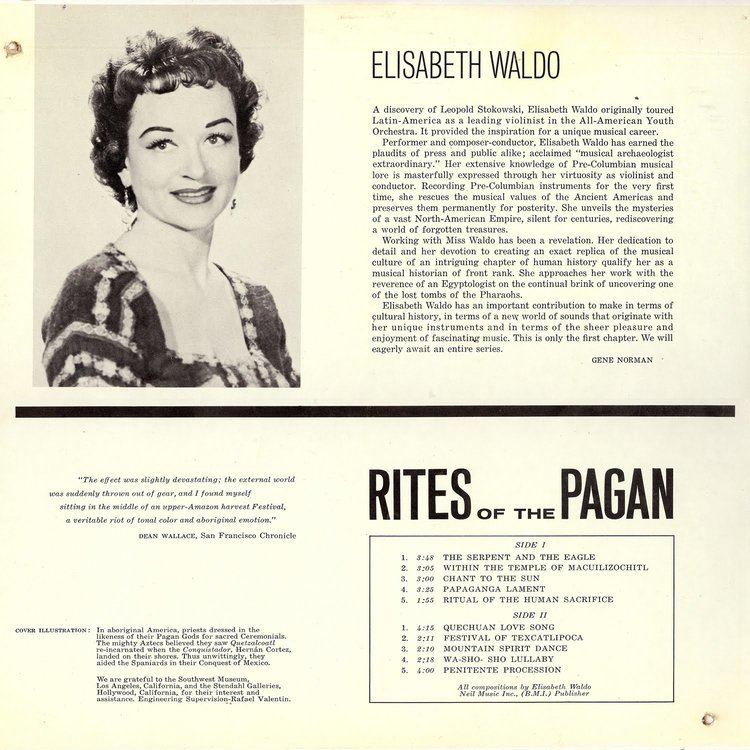Name Elisabeth Waldo Nieces Lucy Lee Siblings Janet Waldo | Role Violinist Nephews Jonathan Barlow Lee | |
 | ||
Elisabeth waldo maracat 1959 stereo exotica full album
Elisabeth Waldo Dentzel (born June 18, 1918) is an American violinist, composer, songwriter, conductor and ethnomusicologist. A scholar of pre-Columbian era music, she was an early adopter of Native American musical instruments among those trained in European classical music.
Contents
- Elisabeth waldo maracat 1959 stereo exotica full album
- Elisabeth waldo realm of the incas 1961 full vinyl lp
- Family
- Early life and career
- Recording and later career
- Albums
- Soundtracks
- References
Elisabeth waldo realm of the incas 1961 full vinyl lp
Family
Waldo was born in Yakima, Washington to Jane Althea Blodgett, a singer trained at the Boston Conservatory of Music, and Benjamin Franklin Waldo, a descendant of Ralph Waldo Emerson. Her sister Janet (1920-2016) was a film, television and voice actress, best known for work on The Jetsons and Josie and the Pussycats.
She married Carl S. Dentzel (1913-1980), who served as director of the Southwest Museum in Los Angeles, and with whom Waldo shared a love of Asian and Native American culture and artifacts. The couple had two sons, Dana Carl Dentzel and Paul Dentzel.
Early life and career
Waldo grew up on her family's ranch at the edge of the Yakima Indian Reservation in Washington State. She started singing at age three and took up violin by age five. Russian violist Jascha Heifetz heard her play and helped her attain a scholarship to the Curtis Institute of Music in Philadelphia where she received a classical music education.
In 1940 conductor Leopold Stokowski invited Waldo to join the newly formed All-American Youth Orchestra. They toured South America in 1940 and then North America in 1941 before disbanding when the U.S. entered World War II. It was on these tours that Waldo's interest in musical archeology grew and she began collecting pre-Columbian instruments.
After the All-American Youth Orchestra, Waldo made her home in Southern California where she played as a first violinist with the Los Angeles Philharmonic for one season. She returned to Latin America as a touring solo performer, playing in Panamá, Costa Rica, Colombia, Peru, Chile, Cuba, and Mexico before taking up residence in Mexico City where she was a regular on the newly networked national radio.
While living there, she collaborated frequently with singer Agustín Lara and appeared in the 1945 film Song of Mexico as a violinist. She also struck up a friendship with muralist Diego Rivera with whom she shared an interest in pre-Columbian and Maya music. Rivera suggested that she develop her own system of hieroglyphic musical notation for working with pre-Columbian instruments in order to teach others how to play them.
In 1954 and 55 Waldo played violin for the Peruvian-American soprano Yma Sumac. Sumac's music fused Andean folk songs with Caribbean rhythms, big band jazz and operatic singing, and her elaborate stage show fit the "exotic" tastes of patrons of venues in Hollywood and Las Vegas, while also meeting the standards of quality to appear in the most prestigious concert halls in North America and Europe. While displaying her talents as a soloist in the orchestra, Waldo regarded her work with Sumac's touring show as part of her research into Latin American music.
Working with arrangers like Les Baxter and Billy May, Sumac helped define the music that would become known as exotica. Inspired by her time with Sumac, Waldo returned to Los Angeles and formed an ensemble that used instruments from Native North, South, and Meso-America to play her own original compositions.
Recording and later career
Waldo was among the first to bring many pre-Columbian instruments into a recording studio for her albums Maracatu (1959), Rites of the Pagan (1960) and Realm of the Incas (1961). Although based on her research in indigenous music, the albums were unlike field recordings of Native American music produced by ethnomusicologists at the time: they were made in the studio using the most advanced high fidelity and stereo recording techniques, and all of the compositions were Waldo's. For these reasons her records would later not be regarded as "world music" but as "new-age music" and then "exotica".
Waldo began scoring film soundtracks in the early 1970s. During the 1980s she became interested in the music of China and formed an ensemble that helped introduce Chinese music and dance for the Los Angeles Unified School District. The group toured several times to China as part of a cultural exchange with several Chinese conservatories. While there, Waldo performed her "Concierto Indo-Americano" with the Xian Symphony Orchestra.
In 1987, Waldo erected the New Mission Theatre, a 150-seat venue for use by the Multi-Cultural Music and Art Foundation of Northridge on the north side of Los Angeles.
